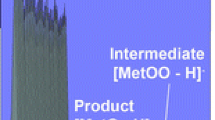Abstract
A stopped-flow-electron paramagnetic resonance (EPR) method was applied for the detection of short-lived radicals of flavonoids bearing a catechol moiety as the B-ring, such as flavonols (quercetin, fisetin, and rutin), flavanones (eriodictyol and taxifolin), flavanols (catechin and epicatechin), and flavone (luteolin). 15N-labeled sodium salt of nitrosodisulfonate (15NDS) was employed to obtain the highly resolved EPR hyperfine structure (hfs) of flavonoid-derived semiquinone radicals under stoichiometrically regulated reaction conditions in aqueous media (pH 10). The EPR hfs of these flavonoids radicals, except catechin and epicatechin, were recorded. Based on the g value and the proton hyperfine coupling constants (hfcc), these flavonoid-derived radicals were assigned to be semiquinone radicals of the catechol moiety (B-ring). For example, the observed EPR hyperfine structure (hfs) of the luteolin radical (Lut−·) was composed of four sets of doublet splitting, which could be ascribed to the three protons of the B-ring (a2′ = 0.136, a5′ = 0.102, and a6′ = 0.272 mT) and a vinyl proton of the C-ring (a3 = 0.099 mT). In addition, the characteristically small doublet splitting resolved for the fisetin anion radical (Fis−·, 0.028 mT) was assigned to the aromatic proton at the C5 carbon of the A-ring, indicating that the unpaired electron of the radials was partially delocalized onto the A-ring through the π bonds involved in the vinyl-carbonyl moiety of the C-ring. The hfcc of the methine protons at the C2 carbon of taxifolin and eriodictyol-derived radicals (Tax−· and Eri−·) was, respectively, evaluated to be 0.102 and 0.230 mT. The assignment of the proton hfcc of flavonoid-derived semiquinone radicals will be discussed in relation with the molecular structure of the C-ring.





Similar content being viewed by others
References
C. Rice-Evance, N.J. Miller, G. Paganga, Free Radic. Biol. Med. 20, 933 (1996)
L. Madsen, C.M. Andersen, L.V. Jorgensen, Eur. Food Res. Technol. 211, 240 (2000)
K. Lemanska, H. Szymusiak, B. Tyrakowska, R. Zielinski, E.M.F. Soffers, I.M.C.M. Rietjens, Free Radic. Biol. Med. 31, 869 (2001)
Ø.M. Andersen, K.R. Markham (eds.), Flavonoids chemistry, biochemistry and applications (CRC Press, Boca Raton, 2006)
P. Knekt, J. Kumpulainen, R. Järvinen, H. Rissanen, M. Heliövaara, A. Reunanen, T. Hakulinen, A. Aromaa, Am. J. Clin. Nutr. 76, 560 (2002)
J. Zielonka, H. Zhao, Y. Xu, B. Kalyanaraman, Free Radic. Biol. Med. 39, 853 (2005)
N. Cotelle, J.-L. Bernier, J.-P. Catteau, J. Pommery, J.-C. Wallet, E.M. Gaydou, Free Radical Biol. Med. 20, 35 (1996)
S.V. Javanovic, S. Steenken, M. Tosic, B. Marjanovic, M.G. Simic, J. Am. Chem. Soc. 116, 4846 (1999)
W. Bors, C. Langebartels, C. Michel, H. Sandermann Jr., Phytochemistry 28, 1589 (1989)
H. Zimmer, D.C. Lankin, S.W. Horgan, Chem. Rev. 71, 229 (1971)
H. Sanuki, R.-K. Watanabe, T. Ideguchi, S. Sakamoto, K. Ichimori, K. Kanaori, K. Tajima, Chem. Lett. 36, 1388 (2007)
O. Dangles, C. Dufour, S. Bret, J. Chem. Soc. 16, 737 (1994)
Y. Sakurai, H. Sanuki, R.-K. Watanabe, T. Ideguchi, N. Yanagi, K. Kawai, K. Kanaori, K. Tajima, Chem. Lett. 37, 1270 (2008)
W. Moser, R. A. Howie, J. Chem. Soc. (A), 3039 (1968)
M. Biler, D. Biedermann, K. Valentova, V. Kren, M. Kubala, Chem. Chem. Phys. 19, 26870 (2017)
S. Selvam, A.K. Mishra, Photochem. Photobiol. Sci. 10, 66 (2011)
M. Friedman, H.S. Jürgens, J. Agric. Food Chem. 48, 2101 (2000)
K. Sabally, S. Karboune, R. St-Louis, S. Kermasha, J. Biotechnol. 127, 167 (2006)
J. A. Kuhnle, J. J. Windle, A. C. Waiss, J. Chem. Soc. (B), 613–616 (1969)
K. Huvaere, K. Olsen, L.H. Skibsted, J. Org. Chem. 74, 7283 (2009)
F. Gerson, W. Huber, Electron spin resonance spectroscopy of organic radicals (Wiley, Weinheim, 2003)
S. Ramesova, R. Sokolova, I. Degano, J. Bulickova, J. Azbka, M. Gal, Anal. Bioanal. Chem. 402, 975 (2012)
J.A. Kennedy, M.H.G. Munro, H.K.J. Powell, L.J. Porter, L.Y. Foo, Aust. J. Chem. 37, 885 (1984)
J.M. Herrero-Martinez, M. Sanmartin, M. Roses, E. Bosch, C. Rafols, Electrophoresis 26, 1886 (2005)
M. Adams, M.S. Blois, R.H. Sands, J. Chem. Phys. 28, 774 (1958)
S. Fiorucci, J. Golebiowski, D. Cabrol-Baxx, S. Antonczak, J. Agric. Food Chem. 55, 903 (2007)
P. Trouillas, P. Marsal, D. Siri, R. Lazzaroni, J. Duroux, Food Chem. 97, 679 (2006)
L.A. Levchenko, S.I. Kulakovskaya, A.V. Kulikov, A.P. Sadkov, A.E. Shilov, Appl. Biochem. Biotech. 88, 201 (2000)
A. J. Dobbs, B. C. Gilbert, R. O. C. Norman, J. Chem. Soc. (A), 124 (1971)
C. Heller, H.M. McConnell, J. Chem. Phys. 24, 764 (1956)
Acknowledgements
This work was partially supported by a Grant-in-aid for Scientific Research (C) (17K07817) from the Japan Society for the Promotion of Science (JSPS).
Author information
Authors and Affiliations
Corresponding author
Rights and permissions
About this article
Cite this article
Kuwabara, K., Sakurai, Y., Sanuki, H. et al. Application of a Stopped-Flow EPR Method for the Detection of Short-Lived Flavonoid Semiquinone Radicals Produced by Oxidation Using 15N-Labeled Nitrosodisulfonate Radical (Fremy’s Salt). Appl Magn Reson 49, 911–924 (2018). https://doi.org/10.1007/s00723-018-1012-3
Received:
Revised:
Published:
Issue Date:
DOI: https://doi.org/10.1007/s00723-018-1012-3




